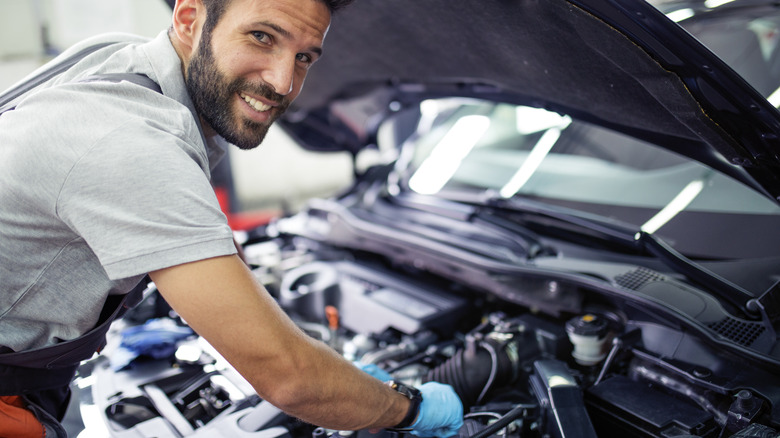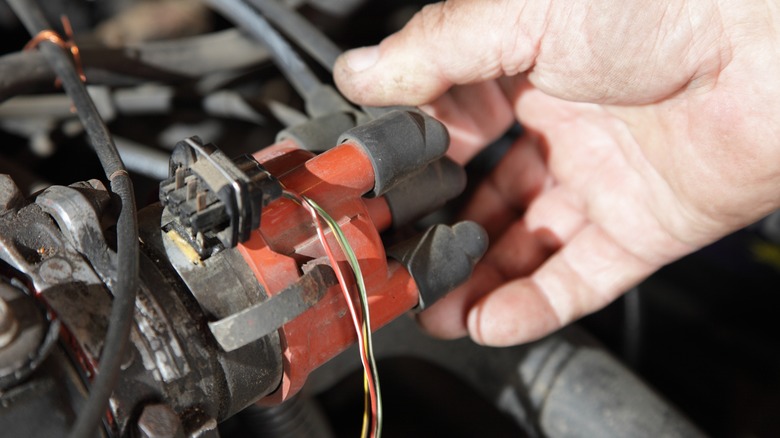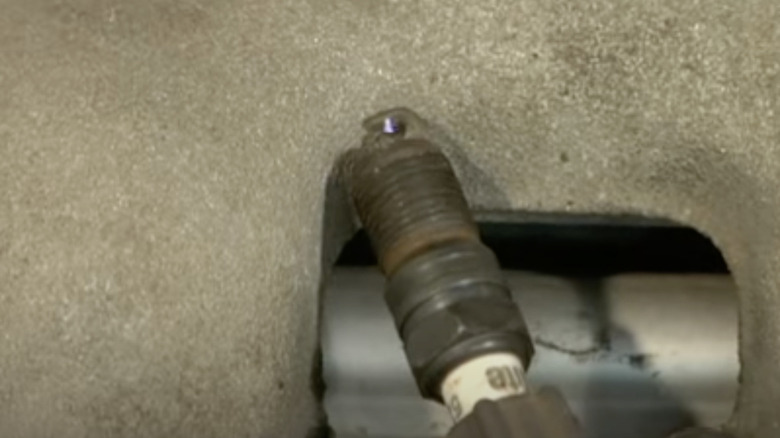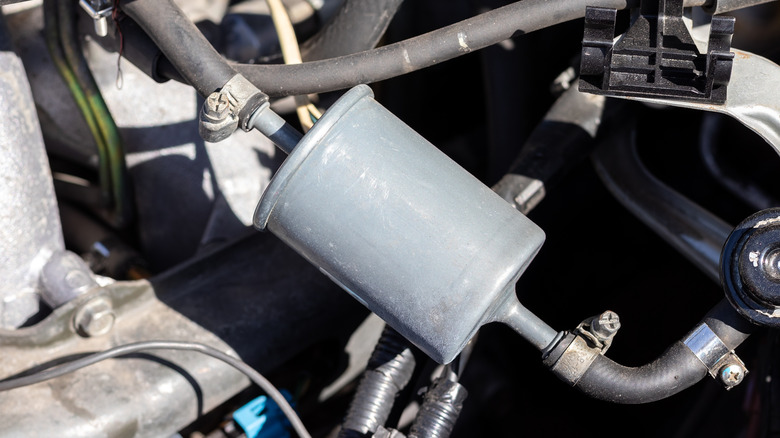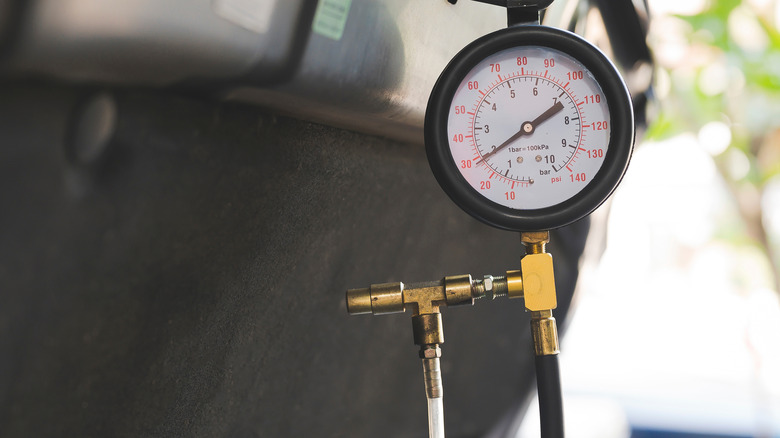What You Should Look For If Your Car Cranks Up But Doesn't Start
Almost every car owner has experienced the frustration of turning the key to find out that their car won't start. Often, the culprit is a dead battery, and SlashGear has already provided tips to check if your battery is toast. If your engine is cranking with gusto but still won't start, what should your next troubleshooting steps be? Automotive engines get their operating energy from a combustive reaction that requires a proper fuel/air mixture and a precisely timed, robust electrical spark to ignite that mixture. If fuel isn't delivered to your engine's cylinders properly, the mixture is off, or the spark is absent or too weak to ignite the mixture, your engine will crank until the battery is drained.
There are simple ways to test for fuel and spark that you can do with a few inexpensive tools, and knowing how to do these basic diagnostics will get you started on your way to fixing your own car or at least give you the knowledge to avoid being taken advantage of by an unscrupulous mechanic. Before you try these tests or do any fiddling with a disabled vehicle, make sure you are in a safe place, well away from traffic, and your parking brake is engaged securely.
Start by checking for spark
Electricity for the engine spark is provided via an ignition coil. The coil takes the relatively harmless 12-volt current from the battery and converts it to the thousands of volts necessary to ignite the fuel/air mixture. On older cars, a single coil feeds current to the distributor, which sends that current to each cylinder via an array of spark plug wires. Newer engines often have individual coil packs mounted on each cylinder, and the GM HEI (high energy ignition) system has the coil integrated with the distributor cap.
The simplest way to check for spark is with an inline spark tester like the ones available from Harbor Freight, Amazon, or any local auto parts store. These tools have a male and female end that allows them to be temporarily installed on a spark plug, the ignition coil's output terminal, or one of the terminals on the distributor cap.
If your engine has a distributor like the one shown in the photo above and a single coil, try testing the output from the coil first. If there is no spark from the coil, there will be none at any cylinders. Simply clip the tester in place and crank the engine. The light inside the tester should flash with each pulse from the coil or distributor, indicating that you have a healthy spark. If your engine has coil packs for each cylinder, install the tester between a pack and its corresponding spark plug.
If you don't have a spark tester
If you don't have a spark plug testing tool, you can check for a spark by removing one of the plugs and grounding it to your car's engine or frame. Crank the starter, and you should be able to see the spark jump the gap between the plug's electrodes, like in the photo above. This test is difficult on engines with coil packs, as the packs themselves are usually grounded via their mounting bolts, and it is often difficult or impossible to complete the coil pack's primary circuit if it's not fully installed on the engine.
If either of these tests indicates that your engine isn't getting spark, it could mean you have a faulty coil, or the electricity supply from the battery to the coil might be interrupted. This could be due to a broken or loose wire, a blown relay or fuse, or bad ground in the primary ignition system. Troubleshooting electrical problems can be tedious and frustrating, but a good electrical multimeter can help you diagnose faulty components and short circuits. If you determine that you have a good spark going to all your engine's cylinders, it's time to check the fuel supply.
Release fuel system pressure before removing hoses
All the spark in the world won't do you any good if there is no fuel in the cylinders to ignite. If you're in a quiet area, you should be able to hear the fuel pump run for a couple of seconds to pressurize the system when you turn the key to the on position. On most modern vehicles, the fuel pump is located in the tank to keep it cool during operation, but some older cars have an inline pump along the frame rail. Regardless of where the pump is, you should be able to find the lines under the hood that feed fuel to your fuel injectors (or carburetor if you have an older car).
To test the fuel supply, first look for a pressure relief valve on the fuel rail near the intake manifold. You can also remove the fuel pump fuse or relay and crank the engine to release fuel pressure. This will prevent flammable gasoline from spraying on a hot manifold when removing fuel lines. Once the fuel system is de-pressurized, go ahead and remove the clamp holding the fuel supply line to the fuel rail (or the filter if it's accessible).
Put the loose end of the fuel hose into an empty plastic bottle and tape the hose securely so it doesn't come loose during the test. Replace the fuel pump fuse if you've removed it, and crank the engine. The bottle should start to fill with fuel.
Your engine might also lack compression
If the supply is weak or nonexistent, you could have a faulty fuel pump. A more scientific way to check your car's fuel supply is by using a pressure test kit like the one we recommended last month as part of a Harbor Freight shade tree mechanic's kit.
A device like this will only test for pressure; every engine also requires a certain volume of fuel per minute to run properly, so you'll want to do a bottle test, too. The service department at your vehicle's dealership should be able to tell you the proper minimum benchmarks for fuel pressure and volume, and they'll likely be impressed that you're doing both of these tests on your own.
If both fuel and spark are present and accounted for, your engine could be lacking a critical third element: sufficient compression. If the cylinders aren't properly sealed by intact gaskets, piston rings, and the like, energy from the combustive reaction will leak out and won't be transferred to the pistons. You can buy a compression test gauge and check each cylinder, but weak compression in one or more cylinders is often a harbinger of doom for an engine, meaning it could need an expensive rebuild, remanufacture, or replacement.
